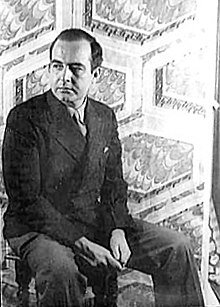Adagio for Strings

Adagio for Strings is a work for string orchestra, arranged by the American composer Samuel Barber from his first string quartet. It is Barber's most popular piece.
Genesis
Barber's Adagio for Strings originated as part of his String Quartet No. 1, Op. 11, composed in 1936. In the original it follows a violently contrasting first movement, and is succeeded by a brief reprise of this music.
In January of 1938 Barber sent the piece to Arturo Toscanini. The conductor returned the score without comment, and Barber was annoyed and avoided the conductor. Consequently Toscanini sent word through a friend that he was planning to perform the piece and had returned it simply because he had already memorized it.[1] Barber's own arrangement for string orchestra was given its first performance by Arturo Toscanini with the NBC Symphony Orchestra on November 5, 1938 in New York.
The composer also arranged the piece in 1967 for eight-part choir, as a setting of the Agnus Dei ("Lamb of God").
Analysis
Template:Sound sample box align right
Template:Sample box end The piece uses an arch form, employing and then inverting, expanding, and varying a stepwise ascending melody.
The long, flowing melodic line moves freely between the voices in the string choir; for example, the first section of the Adagio begins with the principal melodic cell played by first violins, but ends with its restatement by violas, transposed down a fifth. Violas continue with a variation on the melodic cell in the second section; the basses are silent for this and the next section. The expansive middle section begins with cellos playing the principal melodic cell in mezzo-soprano range; as the section builds, the string choir moves up the scale to their highest registers, culminating in a fortissimo-forte climax followed by sudden silence. A brief series of mournful chords serve as a coda to this portion of the piece, and reintroduces the bass section. The last section is a restatement of the original theme, with an inversion of the second piece of the melodic cell, played by first violins and violas in unison; the piece ends with first violins slowly restating the first five notes of the melody in alto register, holding the last note over a brief silence and a fading accompaniment. The adagio has many musical similarities with Mahler's 5th Symphony Adagietto.
Popularity and influence
The 1938 world broadcast debut, with Arturo Toscanini conducting the NBC Orchestra, was selected in 2005 for permanent preservation in the National Recording Registry at the United States Library of Congress.[2]
In 2004, Barber's masterpiece was voted the "saddest classical" work ever by listeners of the BBC's Today programme, ahead of Dido's Lament from Dido and Aeneas by Henry Purcell, and the Adagietto from Gustav Mahler's 5th symphony [1]. The version of the piece performed by London Symphony Orchestra was, for a time, the highest selling classical piece on iTunes. [3]
The piece can be heard in films such as Platoon, The Elephant Man, El Norte, Amélie, Lorenzo's Oil and Reconstruction. Because of this it is used in several episodes of The Simpsons in scenes lampooning sadness and destruction ("Strong Arms of the Ma" and "Marge Gamer").
The choir version is heard in the 1999 PC game Homeworld. A version is also played during one of the game over sequences in Wing Commander IV: The Price of Freedom
An electronic version was made by William Orbit in 1999, and a trance remix of this were made by world renowned Dutch DJ's Ferry Corsten and Tiësto. Tiesto's hard trance remix of the arrangement, which he made in 2005, is considered to be one of the greatest trance remixes of all time and it gained great prominence in the club scene throughout Europe and the world, charting at #37 in the UK and #20 in Ireland. It also featured in Tiesto's set at the 2004 Summer Olympics in Athens, which was televised to 4 billion people globally. Finnish freeform artist Alek Száhala has also remixed the track in 2006, and it is currently waiting to be released.
It was featured in the British TV show Spaced at the end of episode 12 called "Gone". It is used during a fake gunfight as a parody of the Vietnam War film Platoon (film). They also show the famous position that Sgt. Elias makes, seconds before he dies.
The track Interlude off British rock band Muse's album Absolution is a cover version of Adagio for Strings tremolo picked on a guitar with uber gain.
Audio
- BBC.co.uk Sample from the BBC
- modern-strings.de Sample from the Modern-Strings
- modern-strings.de MP3 from the Modern-Strings
- NPR special on the selection of the 1938 broadcast debut of "Adagio for Strings" to the 2005 National Recording Registry
References
- ^ "The Impact of Barber's 'Adagio for Strings'". National Public Radio. Retrieved 2006-12-05.
- ^ "The National Recording Registry 2005". Library of Congress. Retrieved 2007-04-27.
- ^ "Big demand for classical downloads is music to ears of record industry". Guardian Unlimited.

